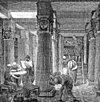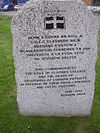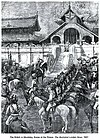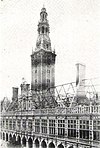
A | B | C | D | E | F | G | H | CH | I | J | K | L | M | N | O | P | Q | R | S | T | U | V | W | X | Y | Z | 0 | 1 | 2 | 3 | 4 | 5 | 6 | 7 | 8 | 9


Libraries have been deliberately or accidentally destroyed or badly damaged. Sometimes a library is purposely destroyed as a form of cultural cleansing.[1]
There are examples of libraries accidentally destroyed by human actions. Others were damaged by natural disasters like earthquakes, floods or accidental fires.
Library fires have happened sporadically through the centuries: notable examples are the destruction of the Library of Alexandria, the destruction of Library of Nalanda in India and the accidental burning of the Duchess Anna Amalia Library in Weimar, Germany.
Causes and prevention
In earlier times mildew was considered a major problem in many libraries, and so the emphasis on library design was to increase air flow by, for example, leaving openings under the shelves in adjoining floors. In a fire, particularly one that starts on any floor except the top level, the flames would be drawn from floor to floor by the air flow, leading quite easily to the destruction of a whole library rather than just a small part.[2]
Advances in technology have reduced the possibility of a library collection being destroyed by fire. These include water sprinklers, fire doors, freezers, alarms, smoke detectors, suppression systems, and emergency generators. Older libraries are usually altered by closing up air flow openings and installing fire doors, alarms and sprinklers. Air conditioning reduces the mold problems. These are all essential parts of new library design.
There is no recovery possible if a book is burnt, so it is accepted that it is better to put out the fire with water and then dry out the books. As mold destroys paper, the books are frozen until they can be dried. This process will damage the book but not destroy it, and the information will be intact.
To reduce the chance of damage from fire, or other causes, and decrease the time needed for recovery after a destructive event, libraries need a disaster management and recovery plan. This can be an ongoing process which will include professional development following updates in technology for key staff, training for the remaining staff, checking and maintaining disaster kits, and review of the disaster plan.
In addition, fire-safety investigations are periodically carried out, especially for historical libraries. The Library of Congress, for example, underwent a year-long inspection beginning in 2000. Before the Congressional Accountability Act of 1995, the Library of Congress and all Capitol Hill buildings were exempt from safety regulations.[3] Balancing historical preservation and contemporary safety standards proves to be a difficult task for "even a 12-year rehabilitation of LC completed in 1997 did not address many fire hazards".[4] After the Compliance Office inspection, however, the LC announced their wholehearted commitment "to achieving the highest level of safety possible" and "the Architect of the Capitol and Library of Congress will report their progress to the Office of Compliance every three months".[3]
Information technology is another reason for careful fire protection. With so many computers in libraries there "is a decrease in floor space and an increase in more compact and powerful computer systems" which generate more heat and require the use of many more outlets, increasing the number of potential ignition sources.[5] From as early as the 1950s the potential dangers of computer equipment, and the facilities that house them, were recognized. Thus, in 1962 the National Fire Protection Association began developing the first safety standards specifically applicable to electronic computer systems.[5] This standard is called NFPA 75 Protection of Information Technology Equipment. FM Global Data Sheet 5–32 is another standard providing guidelines to protect against not only fire, but also water, power loss, etc.[5]
Human action
| Image | Name of the library | City | Country | Date of destruction | Perpetrator | Reason and/or account of destruction |
|---|---|---|---|---|---|---|

|
Library of Ashurbanipal | Nineveh | Neo-Assyrian Empire | 612 BC | coalition of Babylonians, Scythians and Medes | Nineveh was destroyed in 612 BCE by a coalition of Babylonians, Scythians and Medes, an ancient Iranian people. It is believed that during the burning of the palace, a great fire must have ravaged the library, causing the clay cuneiform tablets to become partially baked. This potentially destructive event helped preserve the tablets. As well as texts on clay tablets, some of the texts may have been inscribed onto wax boards which, because of their organic nature, have been lost. |

|
Xianyang Palace and State Archives | Xianyang | Qin China | 206 BC | Xiang Yu | Xiang Yu, rebelling against emperor Qin Er Shi, led his troops into Xianyang in 206 BC. He ordered the destruction of the Xianyang Palace by fire.[6] |

|
Library of Alexandria | Alexandria | Hellenistic Egypt Roman Egypt |
Disputed | Disputed | Disputed,[7][8] see destruction of the Library of Alexandria. |
| Imperial library of Luoyang | Luoyang | Han China | 189 AD | Dong Zhuo | Much of the city, including the imperial library, was purposefully burned when its population was relocated during an evacuation.[9][10]: 460–461 | |

|
Library of Pantainos | Athens | Roman Greece | 267 | Heruli | It was destroyed in 267 AD during the Heroulian invasion and in the 5th century it was incorporated into a large peristyle building. |

|
Hadrian's Library | Athens | Roman Greece | 267 | Heruli | The library was seriously damaged by the Herulian invasion of 267 and repaired by the prefect Herculius in AD 407–412. |
| Library of Antioch | Antioch | Seleucid Empire Roman Syria |
364 | Emperor Jovian[11] | The library had been heavily stocked by the aid of the perpetrator's non-Christian predecessor, Emperor Julian (the Apostate). | |

|
Library of the Serapeum | Alexandria | Hellenistic Egypt Roman Egypt |
392 | Theophilus of Alexandria | Following the conversion of the temple of Serapis into a church, the library was destroyed.[12] |
| Library of al-Hakam II | Córdoba | Al-Andalus | 976 | Al-Mansur Ibn Abi Aamir & religious scholars | All books consisting of "ancient science" were destroyed in a surge of ultra-orthodoxy.[13][14] | |
| Library of Rayy | Rayy | Buyid Emirate | 1029 | Sultan Mahmud of Ghazni | Burned the library and all books deemed as heretical.[15] | |
| Library at Sázava Monastery | Sázava | Holy Roman Empire | c.1097 | Abbot Diethard | After the removal of the Slavonic Benedictines from Sázava monastery, the new abbot destroyed all books written in Old Church Slavonic.[16] | |
| Library of Banu Ammar (Dar al-'ilm) | Tripoli | Fatimid Caliphate | 1109 | Crusaders | Following Sharaf al-Daulah's surrender to Baldwin I of Jerusalem, Genoese mercenaries burned and looted part of the city. The library, Dar al-'ilm, was burned.[17] | |
| Library of Ghazna | Ghazna | Ghurid empire | 1151 | 'Ala al-Din Husayn | City was sacked and burned for seven days. Libraries and palaces built by the Ghaznavids were destroyed.[18] | |
| Library of Nishapur | Nishapur | Seljuk Empire | 1154 | Oghuz Turks | City partially destroyed, libraries sacked and burned.[19] | |

|
Nalanda | Nalanda | India | 1193 | Bakhtiyar Khilji | Nalanda University complex (the most renowned repository of Buddhist knowledge in the world at the time) was sacked by Turkic Muslim invaders under the perpetrator; this event is seen as a milestone in the decline of Buddhism in India.[20] |
| Imperial Library of Constantinople | Constantinople | Byzantine Empire | 1204 | The Crusaders | In 1204, the library became a target of the knights of the Fourth Crusade. The library itself was destroyed and its contents burned or sold. | |
| Alamut Castle's library | Alamut Castle | Iran | 1256 | Mongols | Library destroyed after the capitulation of Alamut.[21] | |
| House of Wisdom | Baghdad | Iraq | 1258 | Mongols | Destroyed during the Battle of Baghdad[22] | |
| Libraries of Constantinople | Constantinople | Byzantine Empire | 1453 | Ottoman Turks | After the Fall of Constantinople, hundreds upon thousands of manuscripts were removed, sold, or destroyed from Constantinople's libraries.[23] | |

|
Madrassah Library | Granada | Crown of Castile | 1499 | Cardinal Cisneros | The library was ransacked by troops of Cardinal Cisneros in late 1499, the books were taken to the Plaza Bib-Rambla, where most of them were burned.[24] |
| Bibliotheca Corviniana | Buda | Hungary | 1526 | Ottoman Turks | Library was destroyed by Ottomans in the Battle of Mohács.[25] | |
| Monastic libraries | England | England | 1530s | Royal officials | The monastic libraries were destroyed or dispersed following the dissolution of monasteries by Henry VIII. | |

|
Glasney College | Penryn, Cornwall | England | 1548 | Royal officials | The smashing and looting of the Cornish colleges at Glasney and Crantock brought an end to the formal scholarship which had helped to sustain the Cornish language and the Cornish cultural identity. |
| Records on Gozo | Gozo | Hospitaller Malta | 1551 | Ottoman Turks | Most paper records held on Gozo were lost or destroyed during an Ottoman raid in 1551.[26] The raid is said to have "led to the near total destruction of documentary evidence for life in medieval Gozo."[27] | |

|
Maya codices of the Yucatán | Maní, Yucatán | Mexico and Guatemala | 1562-07-12 | Diego de Landa | Bishop De Landa, a Franciscan friar and conquistador during the Spanish conquest of Yucatán, wrote: "We found a large number of books in these characters and, as they contained nothing in which were not to be seen as superstition and lies of the devil, we burned them all, which they (the Maya) regretted to an amazing degree, and which caused them much affliction." Only three extant codices are widely considered unquestionably authentic. |

|
Raglan Library | Raglan Castle | Wales | 1646 | Parliamentary Army | The Earl of Worcester's library was burnt during the English Civil War by forces under the command of Thomas Fairfax |
  
|
Załuski Library | Warsaw | Polish-Lithuanian Commonwealth/German-occupied Poland (General Government) |
1794/1944 | Imperial Russian Army/Nazi German troops | After the Kościuszko Uprising (1794), Russian troops, acting on orders from Czarina Catherine II, seized the library's holdings and transported them to her personal collection at Saint Petersburg, where a year later it formed the cornerstone of the newly founded Imperial Public Library.[28] Parts of the collections were damaged or destroyed as they were mishandled while being removed from the library and transported to Russia, and many were stolen.[28][29] According to the historian Joachim Lelewel, the Zaluskis' books, "could be bought at Grodno by the basket".[28] The collection was later dispersed among several Russian libraries. Some parts of the Zaluski collection came back to Poland on two separate dates in the nineteenth century: 1842 and 1863.[28] Government of the re-established Second Polish Republic reclaimed in the 1920s some of the former Załuski Library holdings from the Russian Soviet Federative Socialist Republic following the Treaty of Riga. The original building was destroyed by the Germans during World War II. German soldiers also deliberately destroyed the collection (held in the Krasiński Library at the time - see below) during the planned destruction of Warsaw in October 1944, after collapse of the Warsaw Uprising.[30][31][29] Only 1800 manuscripts and 30,000 printed materials from the original library survived the war. After the war, the original building was rebuilt under the Polish People's Republic.[32][33] |

|
Library of Congress | Washington, D.C. | United States | 1814 | Troops of the British Army | The library was destroyed during the War of 1812 when British forces set fire to the U.S. Capitol during the Burning of Washington.[34] This attack was retaliation for the burning of the Canadian towns of York and Niagara by American troops in 1813.[35] Soon after its destruction, the Library of Congress was reestablished, largely thanks to the purchase of Thomas Jefferson's personal library in 1815. A second fire on December 24, 1851, destroyed a large portion of the Library of Congress' collection again, however, resulting in the loss of about two-thirds of the Thomas Jefferson collection and an estimated 35,000 books in total.[36] |
| Several libraries | Mexico City and major Mexican cities | Mexico | 1856-1867 | Liberal troops and anti-clericalists | During and after the Mexican Reform War, under the liberal governments of Benito Juárez and Ignacio Comonfort, many convent libraries and Church owned school libraries were sacked or destroyed by Liberal troops and looters, most notably included San Francisco Convent Library, which had over 16,000 books (great majority of them were unique collections of Spanish colonial era productions), the library was totally destroyed. Other important libraries included San Agustín Convent Library, was looted and burned. The Carmen de San Ángel Convent and its library were also totally destroyed (with a few books recovered), other affected convent libraries to different degrees were those of Santo Domingo, Las Capuchinas, Santa Clara, La Merced and the Church owned school Colegio de San Juan de Letrán, among others, all of them in Mexico City. Similar events happened all over Mexico, especially in major cities. Besides books, other items such as altarpieces, unique collections of colonial period Baroque paintings, crosses, sculptures, gold and silver chalices (often robbed and melted) were also lost. Total estimates place the total of lost books and manuscripts at 100,000 by 1884.[37][38] | |

|
University of Alabama | Tuscaloosa, Alabama | United States | 1865-05-04 | Troops of the Union Army | During the American Civil War, Union troops destroyed most buildings on the University of Alabama campus, including its library of approximately 7,000 volumes.[39] |
| Mosque-Library | Turnovo, Bulgaria | Ottoman Empire | 1877 | Christian Bulgarians | Turkish books in a library were destroyed when the mosque was burned.[40] | |

|
Royal library of the Kings of Burma | Mandalay Palace | Burma | 1885–1887 | Troops of the British Army | The British looted the palace at the end of the 3rd Anglo-Burmese War (some of the artefacts which were taken away are still on display in the Victoria and Albert Museum in London)[41] and burned down the royal library. |
| Hanlin Academy Library | Hanlin Academy | China | 1900-06-23/4 | Disputed. Possibly the Kansu Braves besieging the west of the Legation Quarter, or possibly by the international defending forces. | During the Siege of the International Legations in Beijing at the height of the Boxer Rebellion, the unofficial national library of China at the Hanlin Academy, which was adjacent to the British Legation, was set on fire (by whom and whether deliberately or accidentally is still disputed) and almost entirely destroyed. Many of the books and scrolls that survived the flames were subsequently looted by forces of the victorious foreign powers. | |
 
|
Library of the Catholic University of Leuven | Leuven | Belgium | 1914-08-25/1940-05 | German Occupation Troops | The Germans set the library on fire as part of the burning of the entire city in an attempt to use terror to quell Belgian resistance to occupation.[42] The library caught again fire during the World War II German invasion of Louvain, Belgium.[43] |

|
Public Records Office of Ireland | Dublin | Ireland | 1922 | Disputed. Poss. deliberately by Anti-Treaty IRA or accidental ignition of their stored explosives due to shelling by Provisional Government forces.[44] | The Four Courts was occupied by the Anti-Treaty IRA at the start of the Irish Civil War. The building was bombarded by the Provisional Government forces under Michael Collins.[45] |

|
Several religious libraries | Madrid | Republican Spain | 1931 | Anarchists and anti-clericalists | In 1931, several groups of radical leftists and anarchists, with the complicit inaction of the Republican government, burned down several convents in Madrid. Most included important libraries. Among them, the Colegio de la Inmaculada y San Pedro Claver and the Instituto Católico de Artes e Industrias with a library of 20 000 volumes; the Casa Profesa with a library of 80 000 volumes, considered the second best in Spain at the time, after the National Library; and the Instituto Católico de Artes e Industrias, with 20 000 volumes, including the archives of the paleographer García Villada, and 100 000 popular songs compiled by P. Antonio Martínez. Everything was lost. |

|
Oriental Library (also known as Dongfang Tushuguan) | Zhabei, Shanghai | China | 1932-02-01 | Imperial Japanese Army | During the January 28 incident in the Second Sino-Japanese War Japanese forces bombed The Commercial Press and the attached Oriental Library, setting it alight and destroying most of its collection of more than 500,000 volumes.[46][47][48] |

|
Institut für Sexualwissenschaft | Berlin | Nazi Germany | 1933-05-?? | Members of the Deutsche Studentenschaft | On 6 May 1933, the Deutsche Studentenschaft made an organised attack on the Institute of Sex Research. A few days later, the institute's library and archives were publicly hauled out and burned in the streets of the Opernplatz. |
| National University of Tsing Hua, University Nan-k'ai, Institute of Technology of He-pei, Medical College of He-pei, Agricultural College of He-pei, University Ta Hsia, University Kuang Hua, National University of Hunan | China | 1937–1945 | World War II Japanese Troops | During World War II, Japanese military forces destroyed or partly destroyed numerous Chinese libraries, including libraries at the National University of Tsing Hua, Peking (lost 200,000 of 350,000 books), the University Nan-k'ai, T'ien-chin (totally destroyed, 224,000 books lost), Institute of Technology of He-pei, T'ien-chin (completely destroyed), Medical College of He-pei, Pao-ting (completely destroyed), Agricultural College of He-pei, Pao-ting (completely destroyed), University Ta Hsia, Shanghai (completely destroyed), University Kuang Hua, Shanghai (completely destroyed), National University of Hunan (completely destroyed).[49] | ||

|
National Library of Serbia | Belgrade | Yugoslavia | 1941-04-06 | Nazi German Luftwaffe | Destroyed during the World War II bombing of Belgrade, on the order of Adolf Hitler himself.[50] Around 500.000 volumes and all collections of the library were destroyed in one of the largest book bonfires in European history.[51] |

|
SS. Cyril and Methodius National Library | Sofia | Bulgaria | 1943–1944 | Allied bombing Allied air forces | |

|
Krasiński Library (housing special collections of the National Library of Poland, including the Załuski Library collection, as well as those of the Warsaw University Library and the Warsaw Public Library) | Warsaw | German-occupied Poland (General Government) |
1944 | Nazi German troops | The library was deliberately set ablaze by Nazi German troops in the aftermath of the suppression of the Warsaw Uprising of 1944. The burning of this library was part of the general planned destruction of Warsaw.[33] |

|
Library of the Zamoyski Family Entail | Warsaw | German-occupied Poland (General Government) |
1944 | Nazi German troops | The library (which housed the collections of the former Zamoyski Academy) was deliberately set ablaze by the Nazi German troops in the aftermath of the suppression of the Warsaw Uprising of 1944. The burning of this library was part of the general planned destruction of Warsaw. Depending on source, 1800 to 3000 items constituting only 1.5% to 3% of the original collection (albeit the most valuable part) survived, partially due to the fact that the troops burning the library did not notice the entrance to the basement at the rear side of the building.[52] |

|
Central Archives of Historical Records | Warsaw | German-occupied Poland (General Government) |
1944 | Nazi German troops | In the aftermath of the suppression of the Warsaw Uprising of 1944, the archives (one of the pair of archives housing historical documents of the Polish-Lithuanian Commonwealth, with the other located in Vilnius) were not only deliberately set ablaze, but the Nazi German troops also entered each of the nine accessible fire-proof vaults in the underground shelter and meticulously burned one after another (entrance to the 10th was blocked by rubble, thus saving its contents). Part of the general planned destruction of Warsaw.[53] |
| Multiple private libraries all over Tokyo. | Tokyo | Japanese Empire |
1945 | US army air force | US firebombing of Tokyo in May 1945 destroyed many private Japanese libraries such as the 40,000 volumes in Hasegawa Nyozekan's house.[54] The firebombing of Tokyo destroyed the majority of personal libraries there with many publications from before the war being permanently lost.[55] Firebombing damaged Keio university in Tokyo.[56] | |
| Warsaw Public Library | Warsaw | German-occupied Poland (General Government) |
1945 | Nazi German troops | Before the outbreak of World War II the library already contained 500,000 book volumes. In January 1945 it was set ablaze by retreating Nazi German soldiers. As a result, 300,000 books were destroyed, another 100,000 were looted.[57] | |

|
Raczyński Library | Poznań | German-occupied Poland (Reichsgau Wartheland) |
1945 | Nazi German troops | The retreating Nazi German troops planted explosives in the building and triggered detonation, demolishing the entire structure and burning 90% of the collection, while the remaining 10% were looted in advance. |

|
Lebanese National Library | Beirut | Lebanon | 1975 | Lebanese Civil War | The 1975 war fighting began in Beirut's downtown where the National Library was located. During the war years, the library suffered significant damage. According to some sources, 1200 of most precious manuscripts disappeared, and no memory is left of the Library's organization and operational procedures of that time. |

|
Zdroj:https://en.wikipedia.org?pojem=Destruction_of_libraries
